Visit the art blog at thematicconversion.tumblr.com and the relog blog at evtrained.tumblr.com.
92 posts
04 Of 05 - Modern Compendium: Kishin Family, Part 3 - Haunt Flying Dutchman
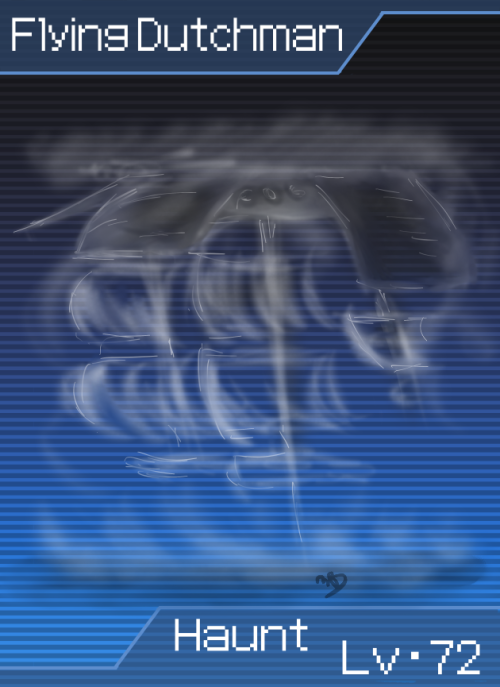
04 of 05 - Modern Compendium: Kishin Family, Part 3 - Haunt Flying Dutchman
One of the more unique ghost stories to be passed around in the last hundred years or so, the Flying Dutchman is one of the cornerstones of the traditional ghost ship story. Though it is fairly uncommon to come across someone who genuinely believes in the Dutchman these days, its mythology has been spread far and wide by sailors, and in modern times, by the series of Pirates of the Caribbean movies.
Tales of the Flying Dutchman may have begun circulating as early as the 17th century, but our earliest actual record of the ghost ship is from 1795, where George Barrington writes in his book, A Voyage to Botany Bay, about a Dutch ship that was lost off the Cape of Good Hope. Thereafter sailors would report a ghostly ship that would attempt to run them down, chasing them all the way to port before vanishing in a black cloud.
These stories were extremely popular for their time, but by the 20th century, people were eager to explain sightings of the Dutchman as drunken illusions on par with the manatees-turned-mermaids, or as a specific kind of mirage called a Fata Morgana, which creates a mirror image of a ship in the sky above the horizon.
Though not many people still believe in the existence of the Flying Dutchman, its mark on global culture is profound and unmistakable. This pedigree is more than enough to secure it a position at the top of the Haunt family.
For more information on and links to every demon in the Modern Compendium, have a look at our Data File, right over (here).
-
 kinemax liked this · 8 years ago
kinemax liked this · 8 years ago -
 abstractscarecrow reblogged this · 10 years ago
abstractscarecrow reblogged this · 10 years ago -
 historyclasses reblogged this · 10 years ago
historyclasses reblogged this · 10 years ago -
 abstractscarecrow reblogged this · 10 years ago
abstractscarecrow reblogged this · 10 years ago -
 abstractscarecrow liked this · 10 years ago
abstractscarecrow liked this · 10 years ago -
 ashtonirwinishot1235-blog liked this · 10 years ago
ashtonirwinishot1235-blog liked this · 10 years ago -
 xerozohar liked this · 10 years ago
xerozohar liked this · 10 years ago -
 downtroddendeity liked this · 10 years ago
downtroddendeity liked this · 10 years ago -
 pawelcyril liked this · 10 years ago
pawelcyril liked this · 10 years ago
More Posts from Historyclasses
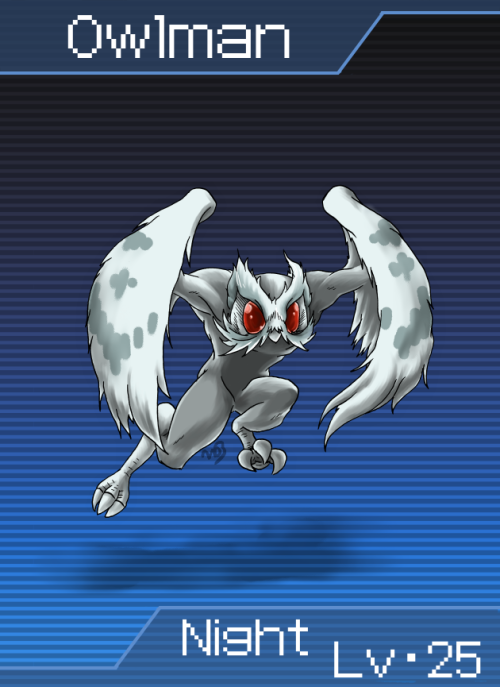
05 of 05 - Modern Compendium: Kishin Family, Part 4 - Night Owlman
First off, a bit of a confession; when I scheduled Owlman for this ALL AMERICAN FIREWORK DEMONFEST, I, uh, thought Owlman had been reported in the United States. I figured hey, we already did Thunderbird, we need an avian to stand in for the Bald Eagle, let’s do Owlman. Imagine my shock when I went back to my research and realized he’s an English critter. Whoops. ^^;
Oh well. Press ahead anyway! Owlman is a Cryptid first sighted in Cornwall, specifically in the village of Mawnan. The first reports painted a picture of a winged man with huge glowing eyes and clawed feet, hovering above the church steeple. Since then, there have been multiple sightings of the beast, all following along similar lines.
Many different solutions to the mystery of the Owlman have been suggested. Some say that the village church lies on a major leyline, and that the Owlman may be an embodiment of the spirit of the land, wreaking vengeance on humankind. Others point out that there are in fact colonies of Eagle Owls nearby, which have a wingspan of something like six feet and whose eyes are enormous and reflect light quite well in the dark. Or, given that the first person to seriously write about the Owlman was a well-known hoaxer named Tony Shiels, it’s entirely possible that the whole thing is just a joke that got out of hand.
At any rate, many people have compared the Owlman to North America’s Mothman, a fact which has always confused me. The Mothman is widely regarded as a sort of latter-day Banshee, bringing warning of disaster along with its menacing fly-bys, but the Owlman has never been seen to do anything but chase folks around and screech a fair bit.
Because of the general shakiness of its base of belief, and because it’s not generally considered actually dangerous or powerful at all, the Owlman sits very low in the Night family. Right at the bottom, as a matter of fact.
For more info on this and every other demon in the Modern Compendium, have a look at our Data File, right over (here).
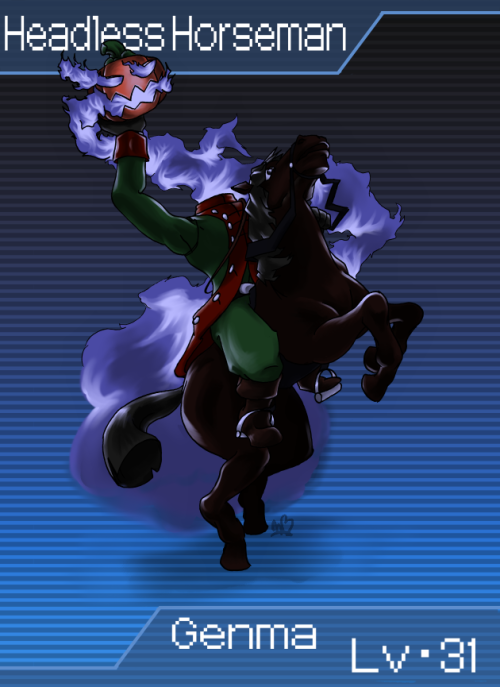
01 of 05 - Modern Compendium: Deity Family, Part 4 - Genma Headless Horseman
Holy crap that took a lot longer than I expected. I did not have a full appreciation for the complexity of this design. @_@
But yes! The Headless Horseman! Introduced to the United States in the early 19th century by Washington Irving’s The Legend of Sleepy Hollow, the Horseman is based on a long-standing tall tale that has surprisingly deep roots in history. Irving’s version of the Headless Horseman is said to be the ghost of a Hessian mercenary who had his head blown off by cannon fire in the Revolutionary War, but there are tales of Horsemen as far back as the Middle Ages. In fact, there’s a good chance that early tales of headless riders were inspired by the long-standing Irish fairy story of the Dullahan, an animated suit of armor that rode a black steed through the countryside, and who could kill simply by speaking the victim’s name.
The Legend of Sleepy Hollow has always been a popular American myth, especially around Halloween, and its impact on pop culture is pretty easy to see. The Horseman appears on Halloween-themed merchandise every year, there’s a popular Disney short about him – hell, there are even high school football teams that have the Horseman as a mascot, and if that doesn’t say mainstream acceptance, I don’t know what does. The Headless Horseman is unique in one interesting way, though; it is one of the few Halloween monsters that have been able to resist the slide into kitsch. You might see cutesy ghosts and witches at Halloween, for example, but a cute Horseman is pretty rare.
As a uniquely American monster, the Headless Horseman fits neatly into the Genma family. He is right at the bottom, but the Horseman is a powerful demon for its level, and would probably qualify as one of the early special Fusions.
For more info on this and every other demon in the Modern Compendium, have a look at our extensive Data File, right over (here).

04 of 05 - Modern Compendium: Kishin Family, Part 4 - Genma Johnny Appleseed
I usually try to shy away from including figures in the Compendium that were actual people, but much like Tokisada in SMTIV, Johnny Appleseed sits at such a crossroad of mythology and culture that his omission would be glaring.
Born in the late 18th century as John Chapman, Johnny Appleseed is unique in the company of modern American folklore in that most of the stories told about him are in fact true. He did travel most of the United States of his time, planting apples, and doing missionary work. It seems he was widely respected by the Native Americans, being allowed to move more or less freely through the lands of several different tribes.
The mythological legacy of Johnny Appleseed is heavily tied in with several significant parts of American identity; He is seen as a settler heading west, expanding the US, personifying self-reliance and the concept of Manifest Destiny; His kinship with the land and animals is a big part of stories told about him in the service of conservation and land management; And of course his missionary work is heavily emphasized by those who see America first and foremost as a Christian nation.
As a perennially popular American figure, Johnny Appleseed fits reasonably high in the Genma family. Really, the only thing that keeps him from being even higher is that he’s never really seen as a force to be reckoned with, but rather as someone who would rather avoid conflict.
For more info on this and every other demon in the Modern Compendium, have a look at our extensive and growing Data File, right over (here)!
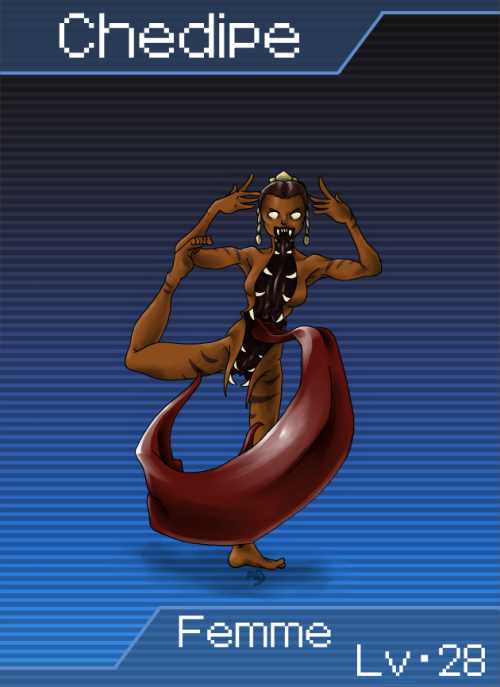
05 of 05 - Modern Compendium: Deity Family, Part 3 - Femme Chedipe
Throughout the Compendium, I’ve tried to include demons that speak not just to modern American sensibilities, but to various cultures all over the world. To that end, the Chedipe is a demon that has a lot to say about the recent history of India and the subcontinent.
The Chedipe is said to be a Vampire-like creature, a woman who seduces men and drains their blood. She sneaks into their rooms at night and drinks their lifeforce from their toes, returning night after night until her victim withers and dies. Legends say she can shapeshift into a tiger, leaping off into the night to escape pursuit, though one of her legs will always remain human. Chedipe are associated with devadasis, the dancing girls that once inhabited Hindu temples, but today these creatures are said to be born from any woman who dies an unnatural death, especially by childbirth.
The association the Chedipe has with devadasis is pretty significant to this demon’s history. See, back when the British colonized India, their utter lack of understanding of Indian culture caused a lot of friction. The British couldn’t tell the difference between devadasis who danced in the temples, and women who danced in the streets for money or for prostitution, so they lumped ‘em all together and outlawed the whole shebang. Between this and the destruction of the feudal lords that patronized temples, the devadasis were forced into the street, often into the very professions that the British had tried to eradicate by outlawing their art form.
I like to think that the Chedipe survived to the 21st century because it represents a memory of the injustices of colonial rule, as well as the lingering fear many women hold of being cast out of their homes with no real means of survival outside of prostitution.
The Chedipe is sometimes described as a witch or enchantress, whose shapeshifting abilities are evidence of some evil alliance. Between this and the demon’s aggressive, dangerous nature, the Chedipe fits neatly into the Femme family.
For more info on this and every other demon in the Modern Compendium, have a look at our Data File, right over (here).
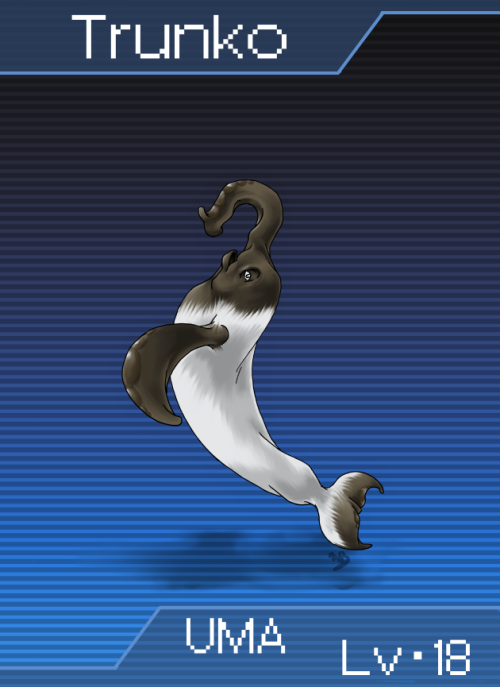
03 of 05 - Modern Compendium: Kishin Family, Part 3 - UMA Trunko
A Cryptid first sighted off the coast of South Africa in 1924, Trunko is an enduringly popular critter, despite very few modern sightings. Perhaps its that ugly-cute coat of fur or the sheer bizarre appeal of an underwater polar bear/elephant/whale hybrid, but either way, this creature is regularly near the top of the list of famous Cryptids.
First seen being attacked by a pair of Killer Whales who battered the animal for three whole hours, Trunko later washed up on the shores of Margate Beach, where it drew a crowd. Beach-goers measured it at 14 feet long, but for some reason, no one managed to get an actual sample of the beast. Heck, to this day there exists only four actual photos of the corpse.
Science, as with so many heavily disfigured Globsters that wash up on shores all over the Earth, is decidedly unimpressed with Trunko. The corpse could easily have been a partially decayed and dismembered whale, especially given the way that tough whale protein “shreds” as it decays, resembling white fur.
Trunko is one of the weaker UMAs, thanks largely to the easy explanations for its appearance and the fact that, despite its popularity, it just doesn’t get seen very much. Its also one of the last UMAs I’ll be designing - there’s only one more to go before this enormous family is done! :o
For more info on this and every other demon in the Modern Compendium, have a look at our Data File, right over (here).